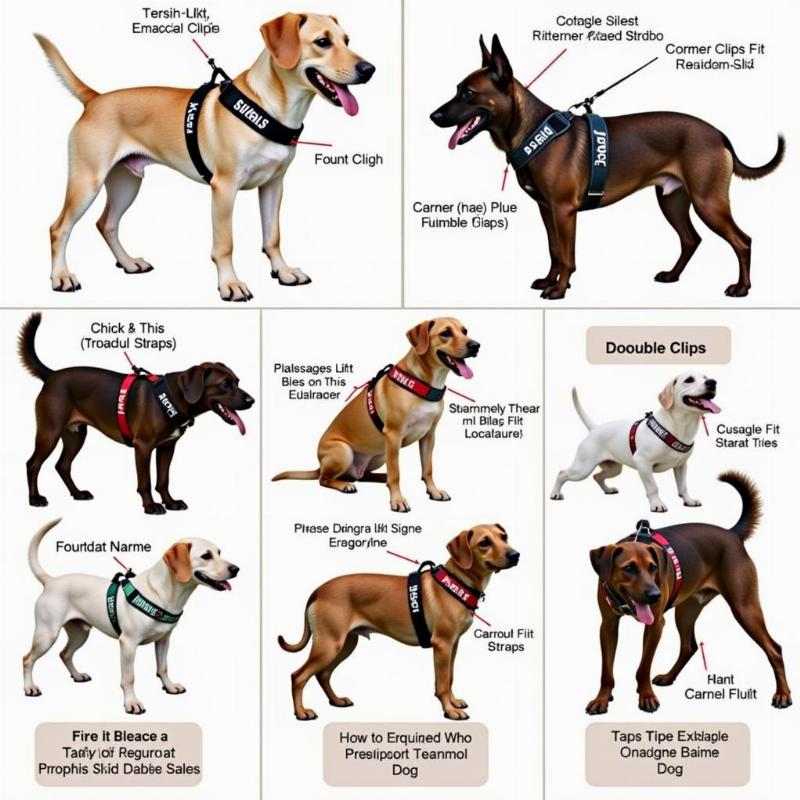A dog slipping out of its harness can be a terrifying experience. This can happen for a variety of reasons, from an ill-fitting harness to a sudden fright. Understanding why your dog slips out of their harness and how to prevent it is crucial for both their safety and your peace of mind. This article provides comprehensive information about common reasons for harness escapes, choosing the right harness, and training techniques to ensure your dog stays securely and comfortably confined.
Why Does My Dog Escape the Harness?
Several factors contribute to a dog’s ability to wriggle free from their harness. Is the harness the right size and fit? A loose harness is an invitation for escape, especially for agile breeds or Houdini-like pups. Consider your dog’s breed and body shape. Some breeds have narrow chests or thick necks that require specific harness designs. Even the material of the harness can play a role. Slippery materials can allow for easier escapes. And don’t forget about behavioral factors! A dog startled by a loud noise or other stimulus might try to bolt, putting extra pressure on the harness and potentially breaking free.
Choosing the Right Harness: A Critical Step
Selecting the appropriate harness is essential for preventing escapes. For dogs prone to backing out, a no-pull front-clip harness can be a game changer. This style gently discourages pulling, reducing the pressure on the harness. Alternatively, a dual-clip harness offers versatility, allowing you to attach the leash to both the front and back, providing maximum control. Measure your dog carefully, following the manufacturer’s guidelines, to ensure a snug but comfortable fit. Durability is key! Opt for harnesses made of strong, durable materials with secure buckles and stitching. dog keeps slipping out of collar offers advice on choosing appropriate collars if you are also considering that option.
Harness Fitting and Adjustment: Ensuring a Secure Fit
Even the best harness won’t work if it’s not fitted properly. Adjust the straps to ensure a snug fit, but allow two fingers to fit comfortably between the harness and your dog’s body. Check regularly, especially for growing puppies, as adjustments may be needed. For specific breeds, consult with a professional groomer or trainer for advice on optimal harness fit. hind leg injury in dogs can occur if the harness isn’t fitting properly and restricts movement, so proper fit is crucial.
Training Tips for Harness Safety
Training plays a vital role in harness security. Positive reinforcement methods, such as rewarding your dog for calmly wearing the harness, can make a big difference. Introduce the harness gradually, allowing your dog to get used to the feeling. Practice leash walking with the harness on in a safe, enclosed area. Desensitize your dog to potentially startling stimuli while wearing the harness to prevent reactive escapes. agility a-frame for dogs can be a great tool to build confidence and improve leash manners while wearing a harness.
Addressing Specific Escape Behaviors
If your dog continues to escape despite a properly fitted harness, address the specific behavior. For dogs who back out, a tighter chest strap and a double-clip harness can be effective. For those who slip out headfirst, a harness with a tighter neck opening or a martingale loop might be necessary. Remember to supervise your dog, especially in new environments or situations. mesh dog harness for small dog might be a better option for smaller breeds.
 Dog Harness Escape Prevention
Dog Harness Escape Prevention
Conclusion: Keeping Your Dog Safe and Secure
A dog slipping out of their harness can be dangerous. Choosing the right harness, ensuring a proper fit, and incorporating training are crucial for preventing escapes. By addressing both the physical and behavioral aspects, you can ensure your dog’s safety and enjoy worry-free walks together. Remember that patience and consistency are key to success. dog weak in back legs may benefit from the support of a well-fitting harness.
FAQ
- How tight should a dog harness be? Snug enough that you can fit two fingers between the harness and your dog’s body.
- What type of harness is best for escape artists? Front-clip, dual-clip, or martingale harnesses can be effective.
- How do I train my dog to not slip out of their harness? Positive reinforcement and desensitization training are key.
- My dog still escapes from their harness. What should I do? Consult a professional dog trainer or groomer for personalized advice.
- Are there specific harnesses for certain breeds? Yes, some breeds require harnesses designed for their unique body shape.
- How often should I check the fit of my dog’s harness? Regularly, especially for growing puppies.
- Can a loose harness injure my dog? Yes, it can chafe or restrict movement, potentially causing injuries.
Beautdogs.us is your premier online resource for dog lifestyle information in the US. We offer expert advice on dog breeds, care, and products. Whether you are a new dog owner or an experienced one, Beautdogs.us is your trusted source for comprehensive and engaging information. Contact us for all your dog-related queries! Email: [email protected] Phone: +1 501-555-7529.